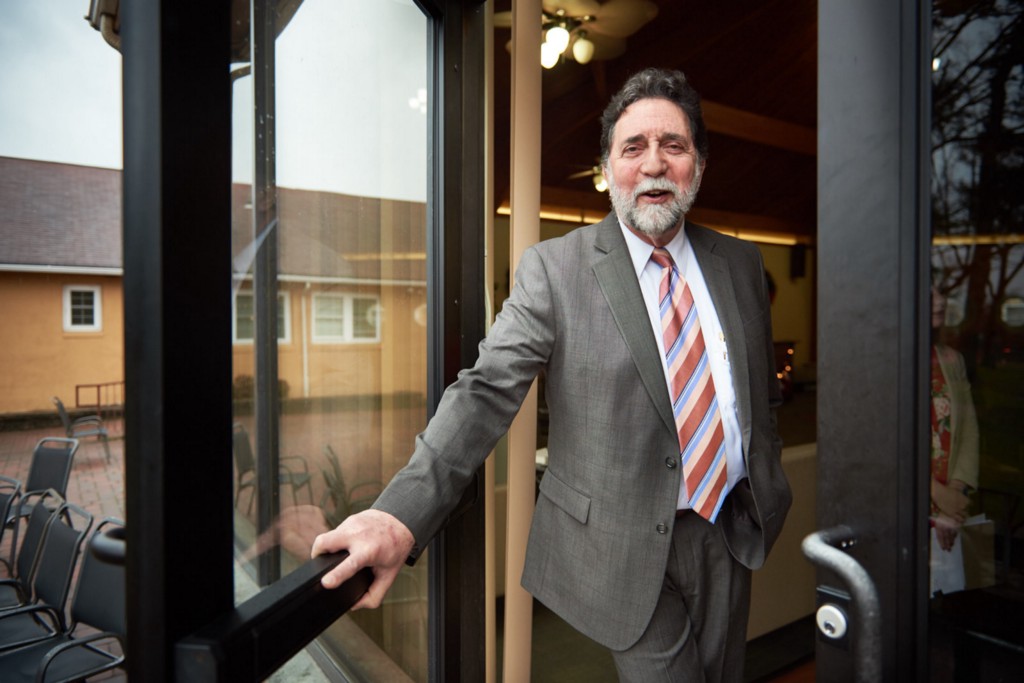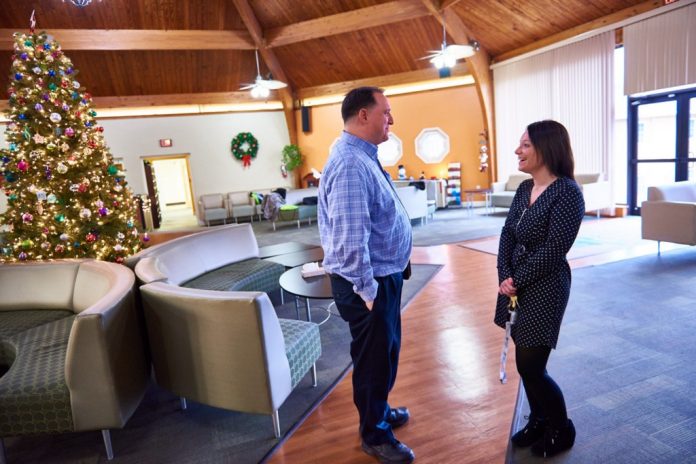Helping hands: John Kronbar, family relations associate, and Stephanie Pietrowski, senior staff technician, talk at Livengrin’s Hulmeville Road campus. The foundation recently celebrated its golden anniversary. MARIA YOUNG / TIMES PHOTO
Dense woods, undulating hills and gently flowing streams shroud the Livengrin Foundation’s Bensalem headquarters, largely isolating the 43-acre addiction treatment facility from the bustling community outside it.
The privacy is clearly by design. After all, alcoholics and drug abusers in the early stages of recovery benefit from the serenity of nature and need not be exposed to the public stigmas associated with their disease as they cope with its emotional, physical and financial consequences.
Livengrin’s Hulmeville Road campus has looked essentially that way since a wealthy and blissfully eccentric advertising executive and entrepreneur, Standish Forde Hansell, purchased the former Brice Farm and founded the nonprofit there in 1966, naming the inpatient facility after a personal mantra: “live and grin.”
Yet, with its golden anniversary commemorations now complete and the foundation embarking on its second half-century, it finds itself engaged in a fierce competition where, ironically enough, public attention might serve as one of its greatest assets.
According to President and CEO Rick Pine, addiction recovery has become big business with countless profiteers vying for the same patients and their managed care dollars. So if Livengrin can publicize its services and successes with a wide audience, it can grow its reputation as a provider of choice — one of the oldest and largest in the region — while ensuring its long-term financial security.
At latest count, the foundation serves more than 4,000 patients and their families per year at eight campuses, including the inpatient facility in Bensalem and outpatient centers in Philadelphia, Bucks County, Montgomery County and Allentown. In the Northeast, there’s a counseling center at 9140 Academy Road and a second office that will open early this year at the Finishing Trades Institute on Hornig Road.
“Livengrin was here doing this work long before there was funding for it, before there were reimbursements for it and before there was public acceptance for it,” Pine told the Northeast Times during a recent tour of the grounds. “And even if the funding were taken away, Livengrin would still be here finding ways to do this work.”
Looking at the latest government data, one can only conclude that the work remains as relevant now as ever. The National Institute on Alcohol Abuse and Alcoholism — a branch of the U.S. Department of Health and Human Services — reports that in a 2014 survey of American adults, almost one-fourth acknowledged that they had engaged in binge drinking during the previous month, while almost 7 percent said that they had engaged in heavy drinking.
According to the institute, binge drinking occurs when someone consumes enough alcohol to raise his or her blood-alcohol content to .08 percent or more. Heavy drinking is when someone consumes five or more drinks in a sitting at least five times during a 30-day period.
Likewise, the National Institute on Drug Abuse reports that in a 2013 survey, about one-tenth of Americans ages 12 and older (almost 25 million people) acknowledged that they had used an illicit drug during the previous month. The vast majority of those folks, about 20 million, had used marijuana. But the survey further revealed that 6.5 million people copped to prescription pill abuse. Other high-ranking substances included cocaine (1.5 million users), hallucinogens (1.3 million), inhalants (500,000) and heroin (300,000).
These numbers show that just about everyone is personally affected or knows someone who is affected by substance abuse. Fifty years ago, Hansell became keenly aware of this enduring human condition.
Upon restoring the old farmhouse, his initial intent was to establish a retirement home where “gentlemen of means” could live out their golden years in comfort and camaraderie. But some trusted friends, including perhaps Orson Welles, convinced him to take a different route. He instead created one of Pennsylvania’s first alcoholism treatment centers not based in a hospital.
In Livengrin’s formative years, Hansell as board chairman networked with businesses and labor organizations to identify those in need of treatment. Although focused on serving the Philadelphia area, the facility attracted patients from across the country. In the 1970s, Livengrin innovated family counseling and outpatient programs to help clients continue the recovery process beyond the acute care stage.
The organization began to incorporate drug-addiction treatment into its continuum of services unofficially at first, then later as part of its stated mission due to an overwhelming need. That is, most patients bring a combination of alcohol and narcotics issues into treatment. In the 1980s, cocaine boomed. After that, mood-altering drugs like barbiturates seemed to grow in popularity, much like opioids and heroin today.
“Our patient community is heterogeneous whereas their drug of choice is not a determinant,” Pine said.
The gender ratio has been a relatively constant two men for every woman over the years, according to the CEO. Patients arrive at Livengrin via referral and voluntary admission. All must undergo an intake assessment.
The Bensalem campus features a medication-assisted detox program with a capacity of 26. It lasts three to five days. Livengrin does not disperse maintenance meds like methadone, but it is licensed to administer medications to help patients deal with withdrawal symptoms. Staff technicians like Stephanie Pietrowski also help new arrivals acclimate despite the physical and emotional challenge.
“Most of them are OK with the fact that they’re here,” Pietrowski said. “They’ve accepted it and they know their families want them here. But they realize (the first day) is probably going to be the hardest day of their life.”
The inpatient rehab program accommodates up to 83 patients at a time on a rolling basis and can last from two to four weeks. The program is built around lectures, group therapy sessions and 12-step meetings within the context of helping patients develop healthy routines.
Each day starts with breakfast, followed by a community meeting, a lecture, a break, group therapy, lunch, a lecture, a break, another lecture, free time, dinner, another lecture, a 12-step meeting and free time. The lights go out at 11:30 p.m.
“We don’t believe and don’t impart on the patient that their time with us is the solution to their problems. It’s a lifelong process and all we do is jump-start their recovery,” Pine said.
Sometimes it works. Many times it doesn’t. Success and failure are difficult to measure statistically, because patients are never truly “recovered.” Recovery is a perpetual condition with the potential for relapse always lurking nearby.
It can happen to anyone at anytime, although certain times seem to trigger it. The year-end holiday period is particularly threatening for many.
For the last four years, John Kronbar has worked as a family relations associate at Livengrin. Two years before that, he was a patient on the verge of quitting. He was 10 days into his program. It was December. And he wanted to go celebrate like everyone else.
“I had my bags packed and was going to leave,” he said.
A worker told Kronbar that his family wanted him to get sober. He convinced Kronbar to stay one more day, then a second day, and a third. Kronbar finished his term and has been sober ever since.
“Being here and being in that turmoil was really a life-changing thing,” he said. ••

Road to recovery: Livengrin Foundation serves more than 4,000 patients annually at eight campuses, including a counseling center at 9140 Academy Road in the Northeast. Above, president and CEO Rick Pine leads a tour of the foundation’s Bensalem headquarters. MARIA YOUNG / TIMES PHOTO





